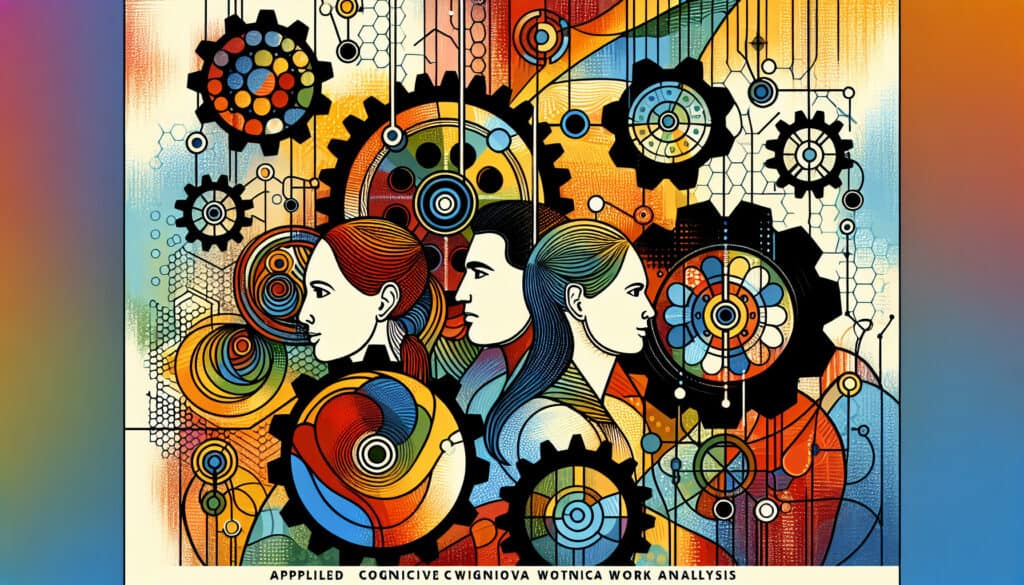A estructura para analizar sistemas sociotécnicos complejos y comprender cómo se realiza el trabajo.
- Metodologías: Clientes y marketing, Economía
Análisis Cognitivo del Trabajo Aplicado (ACWA)

Análisis Cognitivo del Trabajo Aplicado (ACWA)
- Computación cognitiva, Mejora continua, Pensamiento de diseño, Ergonomía, Human Factors, Diseño centrado en el ser humano, Mejora de procesos, Gestión de riesgos, Lenguaje de modelado de sistemas (SysML)
Objetivo:
Cómo se utiliza:
- El ACWA es un método integral de análisis del trabajo que combina elementos del Análisis Cognitivo del Trabajo (CWA) y otras técnicas de análisis del trabajo. Se utiliza para comprender las limitaciones y las posibilidades de un sistema de trabajo y para identificar oportunidades de mejora.
Ventajas
- Proporciona una visión holística del sistema de trabajo, ayuda a identificar las causas profundas de los problemas y puede utilizarse para diseñar sistemas más eficaces y resistentes.
Contras
- Es un método complejo y laborioso, requiere un alto nivel de conocimientos para aplicarlo y puede no ser adecuado para todos los tipos de sistemas.
Categorías:
- Ingeniería, Ergonomía, Resolución de problemas
Ideal para:
- Analizar sistemas de trabajo complejos para mejorar el rendimiento, la seguridad y la capacidad de recuperación.
El Análisis Cognitivo del Trabajo Aplicado (ACWA, por sus siglas en inglés) tiene una aplicación significativa en diversas industrias, especialmente en sectores como la aviación, la sanidad y la fabricación, donde las complejidades de la interacción humana con la tecnología y el entorno requieren un análisis detallado. Esta metodología puede resultar especialmente beneficiosa durante la fase de diseño de nuevos sistemas o procesos, en la que es primordial comprender las necesidades de los usuarios y los contextos operativos. Los participantes suelen ser equipos multidisciplinares formados por diseñadores de sistemas, ingenieros de factores humanos, expertos en la materia y usuarios finales, lo que facilita un examen exhaustivo de las tareas laborales y los objetivos de los usuarios. Por ejemplo, en la atención sanitaria, el ACWA se emplea para rediseñar flujos de trabajo que mejoren la seguridad de los pacientes y la eficiencia de los médicos, mientras que en la aviación ayuda a optimizar el diseño de la interfaz de la cabina para mejorar la toma de decisiones de los pilotos. El método ayuda a detectar problemas latentes en los sistemas de trabajo, como fallos de comunicación o ineficiencias, lo que permite a los equipos proponer intervenciones específicas. Integra modelos cognitivos con técnicas tradicionales de análisis del trabajo, creando un enfoque sistemático para identificar y modelar los conocimientos, habilidades y procesos mentales necesarios para completar con éxito las tareas en entornos de trabajo reales. A través de talleres y sesiones de colaboración, ACWA promueve la alineación de los objetivos organizativos con el diseño centrado en el usuario, garantizando que los sistemas desarrollados no sólo cumplan las normas de rendimiento, sino que también mejoren la satisfacción del usuario y la adaptabilidad a retos inesperados.
Pasos clave de esta metodología
- Definir el ámbito de trabajo y su entorno operativo.
- Identificar las funciones de trabajo y las tareas correspondientes dentro del dominio.
- Analizar las limitaciones impuestas por el entorno de trabajo y las tecnologías.
- Mapear las demandas cognitivas y los conocimientos, habilidades y estrategias asociados que se requieren.
- Evaluar las interdependencias de las tareas y sus repercusiones en el rendimiento laboral.
- Identificar lagunas en los sistemas actuales y áreas de innovación potencial.
- Diseñar intervenciones que se ajusten a las limitaciones y oportunidades identificadas.
- Iterar el diseño basándose en los comentarios de las partes interesadas del sistema.
Consejos profesionales
- Integrar métodos de observación directa en el marco ACWA para captar el conocimiento tácito de los profesionales en el sistema de trabajo, revelando flujos de trabajo ocultos e interacciones sutiles que a menudo se pasan por alto.
- Utilizar talleres con las partes interesadas para explorar en colaboración escenarios de trabajo, lo que mejora la identificación de limitaciones y posibilidades al incorporar diversas perspectivas y experiencias.
- Incorporar la creación iterativa de prototipos de soluciones basadas en las conclusiones de ACWA, lo que permite recibir comentarios en tiempo real y realizar ajustes que se ajusten a las necesidades de los usuarios y a las realidades operativas.
Leer y comparar varias metodologías, recomendamos el
> Amplio repositorio de metodologías <
junto con otras más de 400 metodologías.
Sus comentarios sobre esta metodología o información adicional son bienvenidos en la dirección sección de comentarios ↓ , así como cualquier idea o enlace relacionado con la ingeniería.
Contexto histórico
1986
(si se desconoce la fecha o no es relevante, por ejemplo "mecánica de fluidos", se ofrece una estimación redondeada de su notable aparición)

Publicaciones relacionadas
Gestión de operaciones de fabricación (MOM)
Sistema de Ejecución de Fabricación (MES)
Plan de control de la fabricación
Pruebas manuales
Tablas de evaluación de la manipulación manual (MAC)
ManTRA (Herramienta de evaluación de riesgos en las tareas manuales)